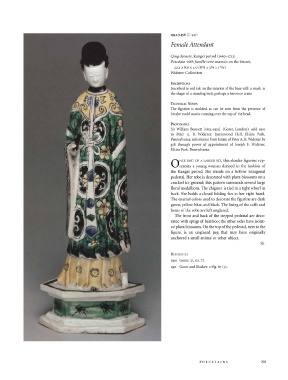Page 217 - Decorative Arts, Part II: Far Eastern Ceramics and Paintings, Persian and Indian Rugs and Carpets
P. 217
1942.9.596 (C-447)
Female Attendant
Qing dynasty, Kangxi period (1662-1722)
Porcelain with famille verte enamels on the biscuit,
22.5 x 8.6 x 5.0 (8 % x 3% x il5/i6)
Widener Collection
INSCRIPTIONS
Inscribed in red ink on the interior of the base with a mark in
the shape of a standing bird, perhaps a heron or crane
TECHNICAL NOTES
The figurine is molded, as can be seen from the presence of
bivalve mold marks running over the top of the head.
PROVENANCE
Sir William Bennett [1852-1931]. (Gorer, London); sold 1910
to Peter A. B. Widener, Lynnewood Hall, Elkins Park,
Pennsylvania; inheritance from Estate of Peter A. B. Widener by
gift through power of appointment of Joseph E. Widener,
Elkins Park, Pennsylvania.
NCE PART OF A LARGER SET, this slender figurine rep-
O resents a young woman dressed in the fashion of
the Kangxi period. She stands on a hollow hexagonal
pedestal. Her robe is decorated with plum blossoms on a
cracked ice ground; this pattern surrounds several large
floral medallions. The chignon is tied in a tight whorl in
back. She holds a closed folding fan in her right hand.
The enamel colors used to decorate the figurine are dark
green, yellow, blue, and black. The lining of the cuffs and
hems of the robe are left unglazed.
The front and back of the stepped pedestal are deco-
rated with sprigs of bamboo; the other sides have isolat-
ed plum blossoms. On the top of the pedestal, next to the
figure, is an unglazed peg that may have originally
anchored a small animal or other object.
SL
REFERENCES
1910 Gorer: 25, no. 77.
1911 Gorer and Blacker: 2: fig. 87 (c).
P O R C E L A I N S 201

